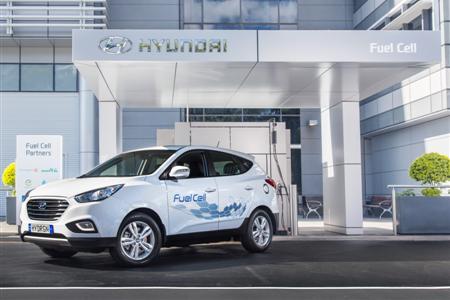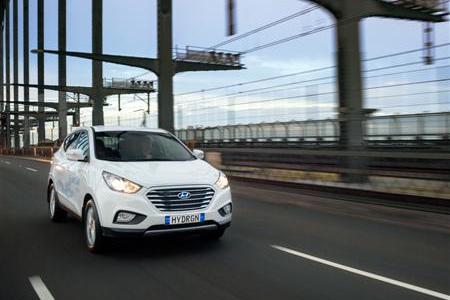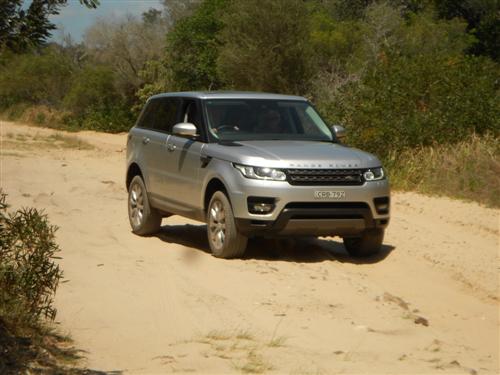|
 Hyundai ix35 Fuel Cell at Hyundai's refuelling point
Hyundai ix35 Fuel Cell at Hyundai's refuelling point
 Hyundai ix35 Fuel Cell crossing the Sydney Harbour Bridge
Hyundai ix35 Fuel Cell crossing the Sydney Harbour Bridge
|
|
|
Hyundai ix35 Fuel Cell in Australia
Home >
News >
Hyundai
Recent new car releases ..... here
Upcoming new car releases ..... here
6th April, 2015
- Hyundai Australia unveils the country’s first hydrogen-powered car – the ix35 Fuel Cell – and opens Australia’s only
hydrogen vehicle refuelling station at its Macquarie Park headquarters
- Hyundai committed to making Hydrogen Fuel Cell cars part of its long-term Australian plans
- World-leading ix35 zero-emissions Fuel Cell Electric Vehicle (FCEV) runs on hydrogen, burns no fuel and emits nothing
but water vapour from its exhaust – range and refuelling time similar to that of a normal petrol-powered car
- The next generation of Hyundai’s FCEV is targeted for introduction by 2018
- ‘Hydrogen Highway’ between Melbourne and Sydney would mirror similar projects in California, USA and Europe
The Federal Industry and Science Minister, The Hon. Ian Macfarlane MHR, last Wednesday (1st April 2015)unveiled
Hyundai’s first hydrogen powered car in Australia, ix35 Fuel Cell.
The Minister also officially opened Australia’s only hydrogen vehicle refuelling station and welcomed the commitment
Hyundai Motor Company Australia is making to bring such leading edge technology to Australian motorists.
The Hyundai ix35 Fuel Cell, hydrogen-powered, zero-emissions Fuel Cell Electric Vehicle (FCEV), built in Ulsan, South
Korea, actually arrived in Australia in June 2014. It is the first hydrogen-powered car to be permanently based in
Australia and it has been undergoing operational trials in the lead up to last week's announcement.
The arrival of the first test vehicle and the commissioning of Australia’s only hydrogen refuelling station are
pioneering steps toward the commercial availability of emissions-free hydrogen powered vehicles in Australia.
“We are taking a bold step into the future and we hope other Australians become as inspired and excited by this
technology as we are,” said Hyundai Motor Company Australia CEO, Mr Charlie Kim.
“In February 2013, Hyundai Motor Company became the first automobile manufacturer in the world to begin
mass-production of a hydrogen-powered vehicle – the ix35 Fuel Cell. The fact that we have brought one to Australia is
testament to how important the Australian market is to Hyundai, and how seriously we take our environmental
responsibility.”
“Because of the way we build our ix35 Fuel Cells, Hyundai Australia has the ability to order these incredible cars
in the same way as we order any new Hyundai cars. We hope to work with governments on all levels to make the technology
more widespread,” Mr Kim added.
Hyundai has installed Australia’s only fuel cell vehicle Hydrogen Refuelling Station (HRS) at its headquarters in
Macquarie Park, Sydney, currently using hydrogen provided by gas partner Coregas Australia, but soon to be making its own
hydrogen on-site through the use of an electrolyser and harnessing solar power. The HRS, supplied by American company Air
Products, is now fully operational.
While investment overseas will see hundreds of HRS’s built throughout Europe and North America in the next five years,
there are currently no known plans by industry for similar infrastructure in Australia.
|
|
|
Next Car's great drives!
Check this out!

Point Plomer Road .....
more
|
|
|
The Road to an Australian Hydrogen Highway
Refuelling stations can generate their own hydrogen by using solar energy and electrolysers – this makes an
alternative transport solution, with neither the fuel generation process nor the hydrogen vehicles themselves
emitting any harmful by-products or burning fossil fuels.
HMCA will soon install an electrolyser at its headquarters in Macquarie Park, along with a solar array to power both
it and the refueller – this will make its HRS fully self-sustainable, with hydrogen made on-site.
Even small refuellers of this kind are relatively expensive. The challenge of making and distributing hydrogen for
mass vehicle use is a significant one.
The Hyundai ix35 Fuel Cell
The ix35 Fuel Cell is one of the most advanced cars in the world, running on hydrogen and emitting nothing but water
vapour from its exhaust pipe.
Hydrogen from the vehicle’s fuel tank is mixed with air and converted to electricity by a fuel cell stack – the
electricity then powers the ix35 Fuel Cell’s electric motor.
The vehicle is near-silent, efficient and emissions-free. It is also very safe, having passed the stringent American
NHTSA crash test. It is as practical and useful as a standard petrol or diesel-powered ix35, with near-identical interior
space and comparable range and performance.
The ix35 Fuel Cell develops 100kW of power and 300Nm of torque and has an official maximum range of 594km. A Hyundai
ix35 Fuel Cell set a record in early July 2014 for the longest journey completed by a vehicle on a single tank of
hydrogen, driving 700km through Norway, Sweden and Denmark.
|
|
|

Self-Catering Holiday
Accommodation in
Denmark, WA
..... more
|
|
|
Private customers are leasing ix35 Fuel Cell Vehicles in Los Angeles as part of an advanced hydrogen scheme, and many
more ix35 Fuel Cells are operational throughout Europe. The delivery of Australia’s first FCEV marks a significant first
step in the longer-term growth of a hydrogen fuel infrastructure in this country.
Q & A: the Hyundai ix35 Fuel Cell and hydrogen vehicle technology
Answers provided by Scott Nargar
Product Planning Manager
Hyundai Motor Company Australia
Q: How does the ix35 Fuel Cell work?
A: It is essentially an electric car, with the electricity supplied by a fuel cell stack. The clever part
happens inside the fuel cell itself - in simple terms, hydrogen from the fuel tank is combined with air and passed
through a membrane, which produces the electricity used to power the car’s electric motor.
This ix35 uses what’s known as a PEM Fuel Cell – PEM stands for Proton Exchange Membrane or Polymer Electrolyte
Membrane. Here’s what happens:
- A fuel cell has two electrodes, an anode and a cathode, separated by a membrane.
- Oxygen passes over one electrode and hydrogen over the other.
- The hydrogen reacts to a catalyst on the electrode anode that converts the hydrogen gas into negatively-charged
electrons (e-) and positively charged ions (H +).
- The electrons flow out of the cell to be used as electrical energy.
- The hydrogen ions move through the electrolyte membrane to the cathode electrode where they combine with oxygen to
produce heat and water.
- The diagram shows how the process works in the car:
Q: Is the hydrogen fuel in the vehicle dangerous?
A: The ix35 Fuel Cell is designed to meet the strictest global vehicle safety standards, like all the safest
cars do – over 30 of the vehicles have been crash-tested to verify its level of safety. It has passed the North American
NHTSA test, one of the world’s toughest.
Many Hyundai ix35 Fuel Cell vehicles are now operational on public roads around the world, including California (USA)
and countries throughout Europe. That is testament to their safety.
The car’s hydrogen tanks are constructed with steel and carbon composite wrap, enough to contain the gas at a maximum
operating pressure of 700bar (10,000psi). The hydrogen tanks have had bullets fired at them, have been put into fire
baths and subjected to other extreme tests like drop test, burst pressure and crash tests to verify their strength – fuel
pressure is greatly reduced before it enters the vehicle’s fuel cell stack.
In short, the ix35 Fuel Cell is an extremely safe car.
It is also worth noting that Australia is quite advanced with the use of other gaseous fuels like LPG and CNG, so
hydrogen gas technology – more advanced than LPG – should represent no great challenge for Australia in safety terms.
Q: What is the specification of Australia’s first Fuel Cell vehicle?
A: It is a left-hand-drive, European-specification ix35 Fuel Cell. This model is currently not made in right
hand drive.
Q: Why is it not made in right hand drive?
A: Due to economies of scale: the vast bulk of these cars are now operating in left hand drive countries,
including the USA, Canada, Denmark, Norway, Sweden and Germany. British road regulations are more relaxed around left
hand drive vehicles than Australia’s, so British cars are also left hand drive until the next generation right hand drive
FCEV that is due in 2018.
Q: How fast is it?
A: The ix35 Fuel Cell accelerates from 0-100 km/h in 12.5 seconds and its maximum speed is 160 km/h. It is
no racing car, but it’s certainly not slow. It’s like a normal car in most ways, but it is an electric vehicle so it
makes no engine noise and has no gearbox.
Q: How long will it take to refuel?
A: With an advanced full-size 700bar (10,000PSI) refueller, like those used in Europe and America, fill time
is about three to five minutes, the same as a normal petrol or diesel car.
The refueller we have installed at HMCA is a small 350bar (5,000PSI) compressor. Fill time is five minutes.
Q: What is the specification of HMCA’s hydrogen refueller?
A: It is a 350bar refueller made by Air Products and Chemicals, Inc. of Allentown, Pennsylvania (USA).
Note that refuelling at 350bar instead of 700bar will mean our vehicle will have a range of approximately 300km.
Q: Does the refueller generate its own hydrogen?
A: Not yet. Initially it will use compressed hydrogen supplied by Coregas Australia in bottled form.
The hydrogen is made by natural gas reformation at Port Kembla NSW.
HMCA is planning to install an electrolyser unit next to the refueller to make hydrogen on-site, using water extracted
from the atmosphere combined with solar power that has been installed on the roof of our building.
We will reveal details of this unit in good time. Meanwhile, the Air Products machine combined with Coregas-supplied
hydrogen serves our purposes well.
Q: Why are you doing this? What is the long-term plan?
A: Although we are fascinated by the potential of a large-scale hydrogen transport network in Australia, we
are – first and foremost – a vehicle manufacturer and an advocate of the technology.
Could a ‘Hume by Hydrogen’ highway be built by 2020? Of course. The potential is there for hydrogen highways and for
even more ambitious plans to power remote communities using solar and hydrogen technology – such schemes could include
completely emissions-free transport built in, with the capability to use hydrogen to store energy for when it’s most
needed.
Over the past two years, discussions have been held with global infrastructure manufacturers, with one even showing
interest in manufacturing the hydrogen stations in Australia.
E&OE.
|